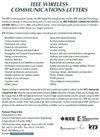Contrastive Language-Signal Prediction for Automatic Modulation Recognition
IF 4.6
3区 计算机科学
Q1 COMPUTER SCIENCE, INFORMATION SYSTEMS
引用次数: 0
Abstract
Automatic Modulation Recognition (AMR) enables intelligent communication and is a critical component of wireless communication systems. Deep learning-based AMR approaches have made significant strides in recent years. These approaches involve inputting signals in the form of images or embeddings into a network, which maps them into high-dimensional feature vectors for subsequent classification. However, radio frequency (RF) signals exhibit significant differences within the same class due to noise or wireless channels. Performing classification based on high-dimensional features may be challenging in capturing robust discriminative features, thereby compromising the model’s generalization ability. To address this limitation, we introduce a novel framework named CLASP, which incorporates language models through contrastive learning, coupling AMR with human language priors to extract robust discriminative features between different categories. Additionally, we treat the prediction of SNR levels as a subtask to acquire auxiliary priors that represent the impact of noise. Extensive results on widely-used datasets demonstrate that CLASP achieves state-of-the-art (SOTA) performance compared to other baselines. As a framework, CLASP exhibits universality and demonstrates superior performance compared to the linear-probe approach across different backbones.用于自动调制识别的对比语言信号预测
自动调制识别(AMR)可实现智能通信,是无线通信系统的重要组成部分。基于深度学习的自动调制识别(AMR)方法近年来取得了长足进步。这些方法涉及将图像或嵌入形式的信号输入网络,网络将其映射为高维特征向量,以便进行后续分类。然而,由于噪声或无线信道的影响,射频(RF)信号在同一类中表现出明显的差异。基于高维特征进行分类可能难以捕捉到稳健的判别特征,从而影响模型的泛化能力。为了解决这一局限性,我们引入了一个名为 CLASP 的新框架,该框架通过对比学习将语言模型纳入其中,将 AMR 与人类语言先验相结合,以提取不同类别之间的稳健区分特征。此外,我们还将信噪比水平的预测作为一项子任务,以获取代表噪声影响的辅助前验。在广泛使用的数据集上取得的大量结果表明,与其他基线相比,CLASP 实现了最先进(SOTA)的性能。作为一个框架,CLASP 具有通用性,与线性探针方法相比,它在不同的骨干网中都表现出卓越的性能。
本文章由计算机程序翻译,如有差异,请以英文原文为准。
求助全文
约1分钟内获得全文
求助全文
来源期刊

IEEE Wireless Communications Letters
Engineering-Electrical and Electronic Engineering
CiteScore
12.30
自引率
6.30%
发文量
481
期刊介绍:
IEEE Wireless Communications Letters publishes short papers in a rapid publication cycle on advances in the state-of-the-art of wireless communications. Both theoretical contributions (including new techniques, concepts, and analyses) and practical contributions (including system experiments and prototypes, and new applications) are encouraged. This journal focuses on the physical layer and the link layer of wireless communication systems.
 求助内容:
求助内容: 应助结果提醒方式:
应助结果提醒方式:


